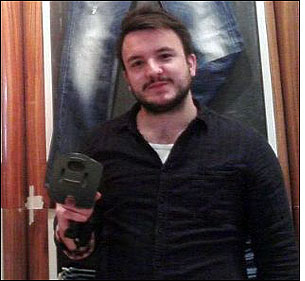A Surplus clothing store in Montreal is using an RFID solution to reduce its inventory process for jeans, down from a full day’s task to just five minutes, thereby allowing the store’s management to gain daily inventory updates regarding the approximately 800 pairs of jeans on its shelves. The system, provided by RFID inventory-control company Overheer Systems, consists of an EPC Gen 2 ultrahigh-frequency (UHF) RFID tag attached to each pair of men’s jeans, as well as a handheld RFID reader, with data from each tag read being stored in Overheer’s Reflect software-as-a-service (SaaS) solution.
Tracking inventory can be a laborious task for a small clothing store with a limited number of staff members who must also attend to customers’ needs. “It can take an entire day,” says Mike Gowing, the manager of the Surplus store located on Boulevard St. Laurent, in Montreal, “and then we have to stop and serve customers, of course.” For that reason, inventory is not conducted as frequently as Gowing would like, thus making it difficult for the staff to know if a certain item or size is mis-shelved, or needs to be replenished. Thus, at least once annually, the store must close its doors for an entire day in order to complete the inventory process.

Surplus is a discount chain that sells luxury branded designer apparel and accessories, including high-end jeans and street wear made by Diesel. Jeans represent the majority of the company’s inventory, and are among the most difficult items to inventory, due to how they are stacked on shelves. Gowing decided to begin with tagging men’s jeans—with a total of about 500 pairs tagged—in early June 2011.
Approximately two months ago, the company began applying passive UHF Gen 2 RFID tags to each pair of jeans, and then stacking the pants on sales-floor shelves. Gowing chose to tag his store’s jeans since they are of high value—and difficult to inventory, because they are placed in stacks up to eight feet high, and are thus cumbersome to count via manual methods. Overheer and Gowing tried two different types of tags: a paper hangtag with an embedded UPM Short Dipole RFID tag, and a Retailers Advantage electronic article surveillance (EAS) hard tag with a built-in UPM DogBone RFID inlay. In both cases, the tags were applied to the jeans at the store. About 25 percent of the tagged items were paper hangtags, according to Phil Lassner, Overheer’s president, while the rest were hard tags. “We wanted to see the read reliability on both,” he states.
In the past, Gowing’s staff had to remove stacks of jeans from a shelf and count them manually, but with RFID, workers simply wave a Motorola Solutions 3090-Z handheld reader past the shelves. With each tag read, the data is transmitted via a Wi-Fi Internet connection to Reflect software residing on a hosted server, according to Dan Sandler, Overheer’s VP. The store can then access that information via the Internet, create a record of what is on the shelf during a particular day and a given employee shift, and compare that information against what the inventory levels should be at that store, based on point-of-sale (POS) and receiving data. In that way, the store can not only ensure that items are replenished before running out, but it can also identify when unpurchased goods leave the store—and, if that is the case, under whose watch they may be disappearing.
Gowing and his sales staff can now complete a daily inventory count in minutes, by simply passing the handheld reader over each shelf, without having to remove the jeans from their stacks.
During the next phase of the deployment, the software will interface with the store’s POS and purchasing systems. If the company chooses to continue using EAS hard tags with built-in RFID tags, it could opt to utilize an RFID reader built into a tag detacher, to read the RFID inlay every time that the EAS hard tag is detached at the point of sale. In this way, the Reflect system would automatically receive data indicating which items were sold, and had had their hard tags removed. This solution could prevent instances of employees either inadvertently or deliberately allowing customers to leave the store with more items than they paid for.
That POS integration is expected to occur later this month, Lassner says. The Reflect software on the handheld devices can also operate in the event that the Internet connection goes down, storing read data until that connection is restored. “They can then repopulate the cloud,” he states.
In the future, Gowing says he expects the company to employ the plastic EAS hard tags exclusively, rather than paper hangtags, since the hard tags enable the use of RFID at the point of sale as the tags are removed. “Plastic tags make more sense,” he notes, “because they also act as a security alarm tag, so we save an extra step.”
Eventually, Gowing hopes the tags could be applied at Surplus’ distribution center, in which case the store’s staff would simply read each tag as tagged items were received, and store that receiving data in the Reflect software.
According to Lassner, Overheer has provided the system to several other apparel retailers in Canada, though these companies have asked that their names not be released.

